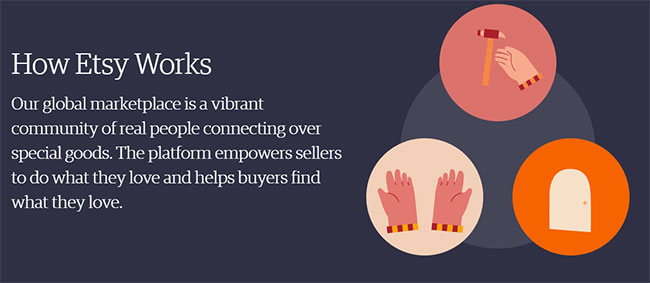If you’re an artist or a crafter who loves creating handmade goods, you might have wondered how to sell on Etsy.
- Inbox Dollars - Get paid to check your email. $5 bonus just for signing up!
- Survey Junkie - The #1 survey site that doesn't suck. Short surveys, high payouts, simply the best.
- Nielsen - Download their app and get paid $50!
Etsy is an e-commerce website that hosts thousands of smaller sellers all over the world who set up their own little “shops” on the website. The concept is similar to eBay, but with a focus on reputable sellers who make their own products.
Today, learn everything you need to know about how to sell on Etsy: how Etsy works, why it’s a good platform for your handmade and vintage crafts, and how to get started selling on Etsy.
What Is Etsy?
Etsy prides itself as a “community of makers, small-business owners, and shoppers who all share a passion for uncommon or rare goods.”
When visiting Etsy, you’ll find that the site focuses on handmade gifts, craft supplies, and vintage items (according to their Terms of Use, “vintage items” are those that are 20 years old or older). They also host manufacturers who sell unique, one-of-a-kind products that you won’t necessarily find anywhere else.
Why Etsy is a Great Choice
Here are some of the biggest reasons why people choose Etsy over other e-commerce marketplaces like eBay:
- It’s very easy to get started. Etsy is extremely user-friendly. You can have your business set up and running in one day.
- You have access to great customer service. If you’re struggling or have a dispute with a customer, you can get help very quickly. Most people who own e-commerce businesses don’t have that luxury and have to deal with everything themselves.
- Etsy is huge. They already attract a lot of buyers which is something any e-commerce business needs to survive. In fact, 81.9 million buyers purchased goods on Etsy in 2020.
- People trust Etsy. They are much more likely to buy something on there than on a new and relatively unknown e-commerce store.
- Etsy offers an easy way to reach an international audience. Etsy helps with the shipping as well. So most of the hard work is taken off your shoulders and you can just concentrate on creating.
- Etsy helps new sellers grow. Your success is their success and your store can become a great additional source of traffic to your own website later on.
Selling on Etsy vs Selling on Your Own Website
You might be tempted to start your own thing and sell your products on your own website.
And I don’t blame you.
Why work under the rules of Etsy, pay them fees for listing and commissions, and sell to a customer base that isn’t actually yours when you can start building your own brand and keep all your commissions to yourself?
But Etsy does have its advantages.
Setting up your Etsy shop is so much easier than setting up your own e-commerce website.
Also, Etsy also helps get your products in front of a lot of eyes via their website and social media. Considering you’ll have to spend much less time and money on marketing your store, this saves you a lot of time and money you can spend on making your goods to sell.
This doesn’t mean you can’t benefit from having both, however.
Get your shop off the ground with Etsy and then start building your own website when you’ve grown a bit.
Etsy is cheaper to start off with but it can become more fulfilling and more practical to get your own website set up for your shop later on. This is especially important in case Etsy ever decides to close your shop on their platform for whatever reason.
Here are a few things you might want to know about starting your own website if you plan on being an Etsy seller.
Things to Consider Before Opening Your Etsy Shop
There are a few things to keep in mind when before starting an Etsy shop.
Most importantly: what will it cost?
Etsy currently has two subscription options to choose from when signing up (you can always change your subscription later).
The options are:
- Etsy Standard is the default and comes with all the basic tools that you need to get your store set up on Etsy. This is free of charge.
- Etsy Plus comes with additional tools, features, and perks to jumpstart your shop’s growth. This costs $10 monthly.
Then, after signing up, Etsy will take $0.20 for every item you list in your shop as part of their listing fee, as well as a 5% transaction fee on every item you sell. A listed item is active for four months or until it is sold.
Lastly, there will be a PayPal processing fee whenever you withdraw money from your Etsy shop to your PayPal account. This fee can be found on the PayPal site. Coincidentally, you can also set it up to have customers pay directly into your PayPal account via Etsy if they pay with PayPal.
No joke. Here are the fastest ways to make easy money online. Click here to see how.
Some other things to keep in mind:
- Keep enough stock handy as Etsy works on a first come, first serve basis. You don’t want to earn a reputation for not being able to fill orders.
- Browse products in the same categories that you want to sell in. You’ll get an idea of what prices people are willing to pay and can price your products competitively.
- Decide on your store policies before you start selling. It’s important to state what your stance is on certain stuff like returns or damaged goods, and how you will handle deliveries.
How to Sell on Etsy: A Step-By-Step Guide
Starting an Etsy shop may seem daunting at first but the process is actually simple and easy to follow.
The first step towards selling on Etsy is to register on the site. Once your account has been created, the fun begins!
Here are the steps.
1. Open your Etsy Shop.
On the Etsy homepage, click on Sell on Etsy,
Select your shop language, country, and currency.
Choose your payment method, that is, where you want to receive your payments. All you need is a PayPal account to receive payments, but if it’s available in your country, Etsy Payments is the way to go. This opens up more payment options to your customers, such as debit cards, Apple Pay, Google Pay, and many more.
You would also need to set up your billing details where your selling fees will be deducted.
2. Choose a shop name and shop title.
More often than not, your shop name is the very first thing Etsy shoppers encounter, and it’s your only chance to make a first impression.
Make sure it is easy to say and remember and reflects your personal brand.
While you’re brainstorming your shop name, you also need to make sure it’s not too similar to that of another Etsy seller.
Best case scenario, it’s inconvenient for everyone (for you, for the other seller, for confused shoppers). Worst case scenario, your shop might be closed by Etsy and you might be banned from the platform.
The shop title is where you can describe what exactly you’re selling on your shop, so make sure you describe your offerings clearly.
3. Set up your shop to showcase your brand personality.
Speaking of first impressions, you want shoppers to understand what your shop is about just by looking at your shop page, which you can think of as your “storefront.”
The key areas on your shop to play up your brand personality are the following:
- Banner. This is the single largest thing shoppers will see when they get to your Etsy shop. Make sure you only use high-quality, high-resolution photos or graphics here.
- Shop logo. Think of your shop logo as your shop’s profile picture. Having a professionally done logo means you’re serious about your branding and makes a good impression on shoppers.
- Seller profile. Your name and photo are much smaller than the other elements, but make sure your name is your real name and your photo is a high-quality profile photo so you inspire trust at first glance.
- About section. You get to tell the story of your brand here. Share videos and photos to show off what makes you and your shop special.
- Shop members. When your shop grows and you need to partner with someone to manage your Etsy shop or to create your products, the names and photos of those people will be shown on this section.
- Shop policies. Information about processing times, estimated shipping times, payment options, returns and exchanges, privacy policy, and FAQs by customers that aren’t addressed by the policies can all be found here.
4. Create your product listings.
You can now add products you’re selling to your Etsy shop. Follow these steps to list your items.
- Add photos or videos. Shoppers want to know exactly what they’re getting. Take a minimum of five high-quality photos of the product from different angles and maybe a couple with a ruler to scale. You can also post a video to give buyers a better look.
- Choose your thumbnail. Keep in mind that this is the first image shopper will see, so this should be consistent with all other thumbnails, as well as with the look and feel of your brand.
- Complete the listing details. Make sure you place the listing in the correct category, use keywords in the product title and description, and utilize all 13 tags to make it easier for shoppers to find your listing.
- Indicate inventory quantity and price. Include how many of the item is in stock. If there are product variants (for instance, size, color, material), make sure to include them all. Price should factor in all costs.
- Enter shipping details. Include processing time, shipping fees, country of origin, and item weight and size.
- Publish! Once a listing is published, it is now available to buy.
5. Develop a marketing strategy.
Selling on Etsy doesn’t begin and end with opening your shop and listing your products.
Marketing involves helping new customers find your shop and letting existing customers know if you have new products or shop updates, all aiming to increase sales.
Here are some marketing tips to get you started.
You can make money from home and it doesn't have to be challenging. Click here to see how.
- Optimize your shop for Etsy search. Add the correct location, use keywords that shoppers are likely to use, and offer free shipping (shops that have free shipping on orders $35 and up are prioritized in the search results).
- Link your shop to social media and vice versa. Social media marketing works on Etsy, so make sure you have a social media presence promoting your Etsy shop. Also, make sure your profile and About section also links to your social media so customers can follow you even outside of Etsy.
- Consider using Etsy Ads. You can promote your listings in Etsy search on ad spaces that are separate from the search results. Know more about Etsy Ads.
6. Manage your Etsy shop.
As your Etsy shop grows, you need to ensure that your Etsy shop is around for the long haul and doesn’t just tank after a few months. Here are some tips for managing your Etsy shop for success.
- Provide stellar customer service. Be around to assist buyers before, during, and after an order is shipped and delivered. Follow up on customers a week or so after they’ve received their order and find out how they feel about their purchase.
- Never stop learning. There’s always something you can do to improve your product listings, marketing efforts, and increase sales. Listen to feedback and keep updated on trends.
- Take a break if you need to. The world doesn’t and shouldn’t revolve around your shop. When you need to put your shop on hold for any reason (you’re traveling, there’s an emergency, or you’re simply overwhelmed), you can turn on Vacation Mode so you don’t need to worry about mounting orders.
How to be Successful on Etsy
Opening your Etsy shop is one thing, but opening and maintaining a successful one is an entirely different thing.
You need to create a brand that people will connect with to stand out above the rest. That means compelling copy, a great-looking page, quality photos of your products, a friendly demeanor when chatting with customers, and great follow-up techniques.
Here are some of the proven tips that work on Etsy which I’ve come across:
Make sure to have enough items listed on the shop. Customers shy away from shops that don’t sell a lot of items for fear of being scammed.
They usually also prefer to order a couple of items at once to save money on shipping costs.
The more items you list on Etsy, the more likely your products are to come up in searches as well. So this is an all-around great tactic for any seller.
Try to change things up every now and then. People go to Etsy to find new and unique stuff. So try to refresh your stock and also try to work in some seasonal items. People love looking for seasonal gifts or items on Etsy!
Focus on writing outstanding product descriptions. You want to make people understand exactly what they’re buying. They can’t feel or see the product in real life so you have to describe it to them and make them want it.
Go Forth and Conquer Etsy!
You might have wanted to start selling on Etsy to earn some side cash from your hobbies, but this could actually be your first step towards your financial independence and a great way to keep doing what you love while earning a living.
Of course, selling on Etsy may not be for everyone. If you think you want to open a business but don’t know where to start, here are a couple of lists of small business ideas and online business ideas.
Or, if you want ideas to earn some side cash to supplement your income from your day job, check out our huge list of side hustles. Who knows, you might be able to save up a decent amount for the capital to start your own business!
What are you planning to sell on Etsy? Or have you already started? Share your thoughts and experiences with us in the comments!







I have always admired your site. I am regular reader of you blog. Thanks for sharing your valuable tips